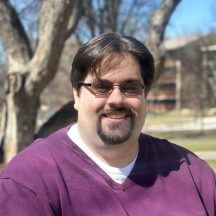LATROBE, PA – After graduating from Saint Vincent College, Ethan Crace, C’14, earned a doctorate in chemistry at Stanford University, completed a postdoctoral appointment at Duke University, published several articles about his scientific research, landed his dream job as an X-ray crystallographer at Colorado State University and discovered a love for making pottery.
“Sorry for being so long-winded,” Crace said while describing his wide-ranging exploits.
Hey, there’s no need for an apology—Crace has crammed a lot of accomplishments into the past decade. That’s no surprise to Dr. Jason Vohs, professor of chemistry in the Herbert W. Boyer School of Natural Sciences, Mathematics and Computing.
Vohs described Crace as “one of those ‘once every 15 years’ type of students”—the kind that stands out even on a campus loaded with intelligent and motivated overachievers. It’s an apt portrayal of Crase, who has long been fascinated with understanding the underlying structure of the world around him.
“I have always enjoyed working with my hands, making new things and trying to understand why I obtain certain results so I can control the outcomes of future work,” Crace said.
By excelling in Advanced Placement and honors classes at Greensburg Central Catholic High School, Crace amassed more than 20 college credits that carried over to Saint Vincent. He placed second on the Wimmer Scholarship Examination, which covered his college tuition for eight semesters.
“The things that stick out to me about Saint Vincent are the small class sizes and one-to-one attention from my professors,” Crace said. “It ensured I really understood the subject matter, and the professors could be more flexible and focus on special topics of interest. We also were able to do much more hands-on work with experimental equipment. It was a much better learning environment than what I saw in the large lecture classes at Stanford, Duke and CSU.”
Vosh recalled how Crace went the extra mile for his senior research project about ways to remove metals from mine runoff in local wetlands.
“He did a synthetic research project in the lab and got great results,” Vohs said. “He then worked with [adjunct chemistry lecturer] Dr. Sarah-Jane Pillsbury on a computational model of what was going on in his flask. While modeling his molecule in a ‘box of water’ sounds simple, it actually was a rather involved affair. The result was a great animation during his senior research presentation.”
At Stanford, Crace worked in the lab of Dr. Hememala Karunadasa, an assistant professor of chemistry who studies the use of hybrid organic-inorganic materials for energy application, such as solar cells, LEDs and batteries. Crace found the job fascinating, but it required long hours and six-day work. “I lost myself in the stress of everything,” he said.
After completing his PhD in 2021, Crace was hired as a postdoctoral researcher at Duke. Still searching for a way to manage stress, he turned to pottery. The process of molding a lump of clay into something beautiful and preparing glazes and other surface treatments is methodical and soothing.
“It was important in helping me find myself again,” Crace said. “Pottery is a very slow and meditative practice which is perfect for clearing my head. It also scratches the itch of my scientific curiosity without [having] to take it super seriously like my research work.”
Creating ceramic pieces involves a lot of chemistry and material science concepts. Demonstrating and discussing his hobby is a vibrant, tangible and tactile way for Crace to welcome others into his world.
“Everyone interacts with ceramics in everyday life. Everyone has played with mud at some point,” Crace said. “It was amazing to see them discover the science that has been hiding in front of them so long.”
This past March, Crace was hired by Colorado State’s Analytical Resources Core (ARC) to manage the X-ray equipment and act as staff crystallographer. He’s still working with pottery and is looking for ways to integrate his hobby and his career.
“I remember the chemistry department at Saint Vincent [offering] non-major classes that explored the chemistry of art and used chemistry techniques to study art,” Crace said. “It appears that idea never left me. I have spoken with a professor in the art department [at Colorado State] in the hope that we can introduce more interactions between artists and scientists so the artists can better understand their materials and produce more complex and interesting pieces.”

Ethan Crace